
EUROPEAN PHYSICAL JOURNAL E
Scope & Guideline
Exploring the nexus of materials science and biotechnology.
Introduction
Aims and Scopes
- Soft Matter Physics:
This area encompasses studies on the physical properties and behaviors of soft materials, including polymers, liquid crystals, colloids, and biological systems. The journal often features research that explores the dynamics, structure, and interactions of these materials. - Complex Fluids and Non-Newtonian Behavior:
EPJ E publishes work on complex fluids, including their rheological properties, flow behavior, and phase transitions. The methodologies include both experimental and theoretical approaches, such as simulations and mathematical modeling. - Biophysical Systems:
Research involving the application of physical principles to biological systems is a core focus. This includes studies on cell mechanics, biomolecular interactions, and the dynamics of living systems, often employing innovative experimental techniques. - Theoretical and Computational Physics:
The journal features theoretical advancements and computational models that aim to predict and explain the behavior of soft matter and complex systems. This includes the development of new algorithms and simulation techniques. - Interdisciplinary Approaches:
EPJ E encourages interdisciplinary research that combines physics with other fields such as chemistry, biology, and engineering, particularly when it leads to novel insights or methodologies.
Trending and Emerging
- Machine Learning and Data-Driven Approaches:
There is a notable increase in research utilizing machine learning techniques to analyze complex systems, optimize processes, and predict material behaviors. This trend reflects a broader movement towards incorporating computational intelligence in physical research. - Active Matter and Self-Organizing Systems:
Studies on active matter, which includes systems of self-propelled particles and biological entities, are gaining prominence. Research in this area explores collective behaviors, dynamics, and interactions that challenge classical physics. - Interfacial Phenomena and Colloidal Systems:
Research focusing on interfacial dynamics, colloidal interactions, and the behavior of droplets in complex fluids is on the rise. This reflects an increasing interest in applications related to materials science and engineering. - Biophysical Modeling and Simulations:
Emerging themes in biophysical modeling, particularly those that use sophisticated simulations to study molecular interactions and cellular mechanics, are becoming more prevalent, highlighting the journal's commitment to interdisciplinary research. - Nonlinear and Non-equilibrium Systems:
There is a growing interest in the study of nonlinear dynamics and non-equilibrium systems, particularly in the context of soft matter and biological systems, indicating a shift towards exploring more complex and less understood areas of physics.
Declining or Waning
- Traditional Liquid Crystal Studies:
Research focusing solely on traditional liquid crystal behavior without integrating newer methodologies or applications has declined. There is a shift towards more innovative applications and interdisciplinary studies involving liquid crystals. - Classical Polymer Physics:
While polymer physics remains important, studies that do not incorporate emerging techniques such as machine learning or advanced simulation methods are less frequently published. The field is increasingly integrated with computational approaches and biological applications. - Basic Fluid Dynamics:
Basic studies of fluid dynamics lacking a strong connection to complex systems or practical applications are becoming less common. The trend leans towards research that connects fluid dynamics with real-world phenomena or interdisciplinary challenges. - Static Structural Analysis:
Research focused solely on static properties and structures of materials without consideration of dynamic behavior or interactions is declining. There is a growing emphasis on understanding the dynamics and functionality of materials in various contexts.
Similar Journals

Frontiers of Physics
Connecting Ideas, Inspiring Physics ExcellenceFrontiers of Physics, published by Higher Education Press, is a premier open-access journal dedicated to fostering innovative research and excellence within the field of physics. With an ISSN of 2095-0462 and an E-ISSN of 2095-0470, this rapidly growing journal has established itself as a valuable platform for disseminating cutting-edge findings, covering a diverse range of topics from theoretical frameworks to experimental advancements. Notably, Frontiers of Physics has achieved an impressive Q1 ranking in the 2023 Scopus Quartiles for Physics and Astronomy, securing a competitive 5th out of 81 positions in its category, reflecting a high impact factor that underscores its importance to the scientific community. Since its inception in 2011 and continuing through 2024, the journal aims to bridge the gap between academia and industry, encouraging collaboration among researchers, professionals, and students alike. Its commitment to open access ensures that high-quality research is readily accessible, thereby promoting knowledge sharing and advancement in the global physics community. Explore the potential of your research in Frontiers of Physics, where the future of physics flourishes.
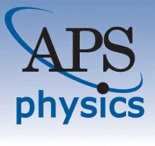
PHYSICAL REVIEW E
Illuminating the Path of Physics InnovationPHYSICAL REVIEW E, published by the American Physical Society, stands as a premier journal in the fields of condensed matter physics, statistical and nonlinear physics, and statistics and probability. With an ISSN of 2470-0045 and an E-ISSN of 2470-0053, this journal prides itself on providing cutting-edge research and insights, contributing significantly to the advancement of knowledge since its inception in 1993. Currently, it boasts a Q1 ranking in Condensed Matter Physics and a Q2 ranking in both Statistical and Nonlinear Physics and Statistics and Probability, highlighting its relevance and impact within these fields. PHYSICAL REVIEW E is particularly renowned for its commitment to disseminating high-quality, peer-reviewed articles that address fundamental questions and emergent phenomena, making it an essential resource for researchers, professionals, and students alike. As it converges years from 1993 to 2024, the journal continues to foster a collaborative environment for innovative research while maintaining accessibility for a global audience.
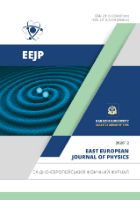
East European Journal of Physics
Connecting minds across the realm of Physics.The East European Journal of Physics, published by the V N Karazin Kharkiv National University, is a dynamic open-access journal dedicated to advancing research in the fields of Physics and Materials Science. Since its inception in 2014, the journal has become a platform for scientists and academicians throughout Eastern Europe and beyond, fostering collaboration and dissemination of innovative studies and findings. With its ISSN 2312-4334 and E-ISSN 2312-4539, it attracts a global readership and submissions that are rigorously peer-reviewed to ensure the highest scholarly standards. Despite currently holding a Q4 category ranking in both Materials Science and Physics and Astronomy, as well as modest Scopus rankings, the journal is positioned to play a crucial role in elevating the visibility and impact of research emanating from this geographically and scientifically significant region through an open access model. This commitment to open scholarship is critical for fostering academic exchange and impact, making the East European Journal of Physics a valuable resource for researchers, professionals, and students seeking insight into the latest developments within these fields. Join us in exploring the frontiers of knowledge and innovation from Ukraine and its surrounding areas.
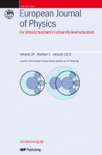
EUROPEAN JOURNAL OF PHYSICS
Fostering Dialogue in the World of PhysicsEuropean Journal of Physics, published by IOP Publishing Ltd, is a premier international journal serving the diverse field of physics and astronomy. With a commitment to advancing scientific knowledge since its inception in 1980, the journal provides a platform for original research articles, reviews, and topical discussions in various domains, including theoretical and experimental physics. Operating out of the United Kingdom, the journal has achieved a commendable Q2 ranking in the Physics and Astronomy (miscellaneous) category for 2023, reflecting its robust influence in the academic community, alongside a notable Scopus Rank that underscores its relevance in both the Social Sciences and General Physics and Astronomy fields. Although it does not currently offer open access, the journal's traditional publication model ensures rigorous peer review, maintaining high scholarly standards that are imperative for researchers, professionals, and students striving to stay ahead in their respective fields. Don't miss the opportunity to engage with cutting-edge research and contribute to the ongoing dialogue in physics by accessing this vital resource.

European Physical Journal Plus
Catalyzing Progress in Fundamental and Applied SciencesThe European Physical Journal Plus, published by Springer Heidelberg, is a reputable open-access journal that serves as a vital platform for innovative research across various disciplines, including physics, astronomy, and chemical engineering. With an impressive impact factor reflected by its Q2 ranking in both Fluid Flow and Transfer Processes and Physics and Astronomy (Miscellaneous) categories, this journal plays a crucial role in disseminating high-quality research findings. Since its inception in 2011, it has fostered interdisciplinary collaboration and encourages the exploration of fundamental principles and applications. The journal also boasts a respectable Scopus rank, indicating its solid influence and reach within the scientific community. Researchers, professionals, and students alike will find the journal to be an essential resource for staying abreast of advancements and trends in these dynamic fields, while its open-access model ensures that valuable insights are accessible to a broader audience.
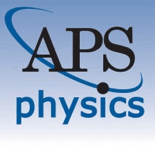
PHYSICAL REVIEW B
Advancing Understanding in Condensed Matter PhysicsPHYSICAL REVIEW B, published by the American Physical Society, is a leading journal in the field of condensed matter physics and materials science, particularly focusing on electronic, optical, and magnetic materials. With an ISSN of 2469-9950 and an E-ISSN of 2469-9969, this periodical has garnered a prestigious reputation, achieving a Q1 ranking in both relevant categories as of 2023. The journal has recorded significant impact as reflected in its Scopus ranks, notably positioned at #95 out of 434 in Condensed Matter Physics and #75 out of 284 in the Materials Science sector, illustrating its importance in advancing research and discussions in these critical areas. Although it does not offer open access, PHYSICAL REVIEW B remains an invaluable resource for academics, researchers, and professionals seeking to increase their understanding of contemporary issues in condensed matter and material sciences. Established in 2005, this journal continues to foster innovation and dissemination of knowledge, making it a cornerstone publication for those engaged in cutting-edge research.
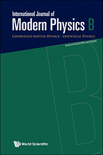
INTERNATIONAL JOURNAL OF MODERN PHYSICS B
Unveiling the complexities of modern physics through peer-reviewed excellence.The INTERNATIONAL JOURNAL OF MODERN PHYSICS B, published by WORLD SCIENTIFIC PUBL CO PTE LTD from Singapore, represents a pivotal platform for researchers in the fields of Condensed Matter Physics and Statistical and Nonlinear Physics. With a rich history spanning from 1996 to the present, the journal aims to foster cutting-edge research and innovative theoretical advancements, presenting high-quality peer-reviewed articles that address contemporary challenges in modern physics. Although it operates under a traditional access model, the journal maintains a notable impact, with a commendable ranking within the Scopus metrics – positioning it in the 63rd percentile for Statistical and Nonlinear Physics and the 53rd percentile for Condensed Matter Physics. The Q3 category ranking further underscores its relevance and growing stature in the scientific community. This journal is essential for physicists, researchers, and students seeking to keep abreast of the latest developments and theoretical insights in these dynamic areas of study.
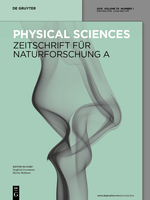
ZEITSCHRIFT FUR NATURFORSCHUNG SECTION A-A JOURNAL OF PHYSICAL SCIENCES
Pioneering Insights in Theoretical ChemistryZEITSCHRIFT FUR NATURFORSCHUNG SECTION A - A JOURNAL OF PHYSICAL SCIENCES is a distinguished journal published by Walter de Gruyter GmbH, based in Germany, that serves as a vital platform for research in the realms of mathematical physics, physical and theoretical chemistry, and broader disciplines within physics and astronomy. Established in 1946, this journal has been a cornerstone for scientists and researchers, providing rigorous peer-reviewed articles that push the boundaries of knowledge in physical sciences. With a notable 2023 Scopus ranking reflecting its respected position in the field—Q3 in mathematical physics, physical and theoretical chemistry, and miscellaneous physics and astronomy—this journal not only emphasizes high-quality research but also enhances the visibility and impact of contributions within these areas. Although it does not currently offer open access, the insights shared in its pages are invaluable for advancing academic inquiry and sparking interdisciplinary collaborations. As it looks ahead to 2024, ZEITSCHRIFT FUR NATURFORSCHUNG SECTION A continues to invite contributions that align with its mission to foster an understanding of complex physical phenomena, making it an essential resource for academics, professionals, and students alike.

Jurnal Fizik Malaysia
Advancing Physics Knowledge, One Article at a Time.Jurnal Fizik Malaysia is a prominent academic journal dedicated to advancing the field of physics, published by the esteemed Institut Fizik Malaysia. With an aim to foster knowledge dissemination and research collaboration among physicists, the journal serves as a vital platform for original research articles, reviews, and technical notes that cover various sub-disciplines of physics. Although the journal operates under a traditional subscription model, its commitment to quality has been bolstered by a rigorous peer-review process, ensuring high academic standards. Researchers and students in Malaysia and beyond are encouraged to engage with this journal, contributing to a deeper understanding of physical sciences and its applications. Moreover, with its ISSN 0128-0333, Jurnal Fizik Malaysia continues to play a significant role in the scientific community, enhancing visibility and accessibility for local and international research outputs in the ever-evolving landscape of physics.
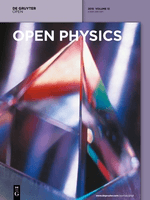
Open Physics
Fostering collaboration in the realm of physical sciences.Open Physics, published by DE GRUYTER POLAND SP Z O O, is a leading open access journal dedicated to advancing the field of physics and astronomy. Established in 2015, this journal not only promotes the dissemination of innovative research but also emphasizes accessibility, allowing researchers, professionals, and students alike to freely engage with the latest advancements in various physics disciplines. With an impact factor that positions it within the Q3 category of the broader physics and astronomy community, Open Physics currently holds a respectable ranking of #102 out of 243 journals in its field according to Scopus, placing it in the 58th percentile. The journal encourages rigorous scholarship and the sharing of knowledge within a collaborative environment. Based in Germany, with its editorial office located in Warsaw, Poland, Open Physics is dedicated to fostering international dialogue and interdisciplinary research, making it an essential resource for those shaping the future of physical sciences.